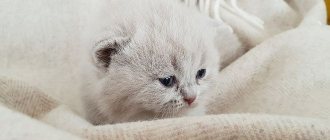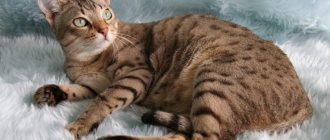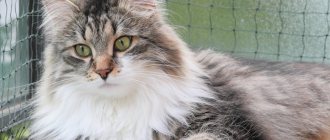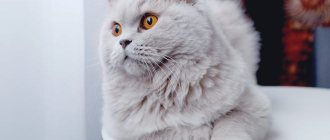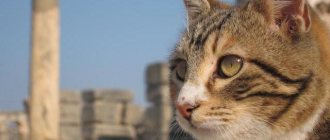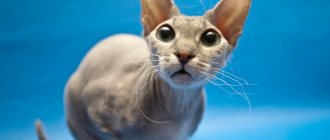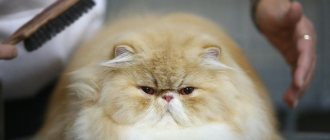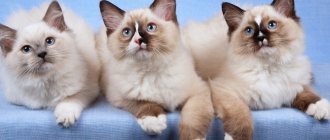For many, the “typical British” is a blue-gray cat with bright orange eyes. But in fact, the British cat breed can surprise you with more than 200 different coat colors! Felinologists group them into categories:
- plain;
- color point (Siamese colors);
- tortoiseshells (variegated);
- tabby (striped, spotted);
- chinchillas (shaded colors);
- smoky;
- colors with white.
Let's get to know each type of British color in more detail.
Video
* We invite you to watch a video about the British Shorthair cat . In fact, in front of you is a playlist in which you can select and watch any of 20 videos about a given cat breed by simply clicking on the button in the upper right corner of the window. In addition, the material contains quite a lot of photos. By looking at them you can find out what a British Shorthair cat looks like.
Rate the material!
[Total votes: 5 Average: 5]
The British Shorthair cat is a beloved pet that captivates the hearts and souls of its owners with its grace, beauty and affection. Such animals are smart and learn quickly, which makes keeping them in the house very simple. This breed is considered the most popular in Russia.
Story
The history of the British Fold cat breed dates back to the Second World War. The British had many nurseries where there were animals very similar to British cats. However, the merciless war did not save these animals. And after the end of hostilities, breeders had to collect the lost breed bit by bit. For this we took: Persian cats, exotics and French blues. The result exceeded all expectations. A completely new breed. The breed of fold cats is a new pet with a unique character.
Over time, it was exported to other countries: Holland, Belgium, France. Animals came to Russian territory much later, in the early 90s of the 20th century.
Interesting fact: the Briton's first color was blue. It is this type of cat that is radically different from other animals of this breed. The history of their work is much longer than that of the others, since they were the first. By the way, the fur of British cats will be different. British Blues are shorthaired and have better texture.
© shutterstock
History of the origin of British Shorthair cats
Representatives of felinology still cannot agree on the origin of British cats.
Today there are two main versions, each of which has its own list of supporters:
- France. Many felinologists believe that the history of the British is closely connected with their fellow French - the Chartreuse cat breed. According to scientists, representatives of these groups were brought to Europe from Africa at approximately the same time. The new breed was first bred by monks. Cats came to Britain through ships, where they served as rat catchers. This theory is confirmed by the similarity between the British and the Chartreuse;
- Rome. Delving into history, you can find interesting facts about the conquest of Britain by Rome. It is with this event, according to felinology scientists, that the emergence of this breed on British soil is connected. Felinologists believe that the Romans brought Roman cats to Britain, which, in turn, quickly adapted to the new land and were loved by its settlers. This version of origin is confirmed by numerous mass graves of cats that were discovered by archaeologists in Britain.
Only one thing can be said with certainty: the real history of cats began in Britain. It is here that the earliest depictions of British Shorthairs were discovered, dating back to around the 700s. Small pictures of animals were applied to colored miniatures.
Interesting fact: There were images of representatives of this breed in books. So, in the 800s, in a handwritten book, one of the Irish monks drew a British shorthair cat and wrote that such an animal really brightens up the monastic everyday life, making them more interesting.
In the 10th century, the cult of the British only increased. At this time, the Celtic sculptor, when creating a stone cross with scenes from the Passion of Christ, did not forget to add cats. One had a small kitten in his paws, and the other had a chick. Around the same time, a law was passed in Britain to protect cats. Representatives of this breed were very expensive.
Attitude to the class division of society
In Great Britain, society is strictly divided into classes, and the characteristics of class division are firmly fixed in the consciousness of the British. Each person belongs to a certain class depending on the origin of his parents and upbringing. Class is important information about a person in the UK.
Changing from one class to another is very difficult in the UK, unlike in the US. This is only possible through generations - according to scientists, this requires as many as 10 generations! Inter-class marriages are extremely rare. A particular person cannot go beyond the boundaries of his class, no matter how hard he tries - neither wealth, nor influence, nor profession will change this.
Manners, taste, habits and other indicators of class cannot be eliminated or disguised. How impossible it is to change your school and university education - and this is a very important indicator of class. Other indicators of class include accent, profession, connections, and even zip code. You can learn a lot about an Englishman from one index, so when meeting or describing a person, the British often mention their place of residence instead of their profession.
If an Englishman still wants to upgrade the class of his children or grandchildren, he needs to make a huge effort to do this. But almost no one does this - Englishmen from any class are happy with everything. You can earn a lot of money even in the lower class, but no one wants to get an impractical, expensive education, change habits, learn a different dialect, wear unusual clothes and communicate with people who are not interesting to them.
British Shorthair cat - description of the breed
British shorthair cats are the most ancient representatives of large cats. The original name of the breed was “British Blue”. This is due to the peculiarity of the pet’s iridescent color. The new name is also associated with wool, only this time not with color, but with length: “Shorthair”.
The British are quite strong and robust pets, characterized by medium and large dimensions.
The main descriptive features of the body structure are:
- Round head, widened at the cheekbones. The neck of cats is very thick (almost invisible), but at the same time short;
- Expressive muzzle. The nose is short and straight. He is vertical with a strong chin;
- Big eyes. The look is one of the main characteristics of the British. The eyes of these cats are large, wide open and set far apart. They can be orange or blue. The shade of the eyes depends on the color of the animal;
- Squat body. The body of the animals is straight, the back is short, and the shoulders are massive;
- Short legs. At the same time, cats’ paws are very strong and large;
- Thick tail. This part of the cat's body is not very long. The tail is rounded at the end;
- Thick and short fur. The most important feature of animals of this breed. The British coat is shiny, medium soft/hard and has a dense texture.
In general, representatives of the British Shorthair look very attractive and graceful. It was their appearance that became the reason for the increased love for them from people. What attracts most about the British is their look and fluffy big cheeks, which children love to squeeze.
Average whole adult: 6-9 kg (males) and 4-6 kg (females). Height at the withers is 28-33 cm. The life expectancy of pets is 15-20 years. This period largely depends on the Briton’s habitat, conditions of detention, nutrition and treatment. Animals need regular vaccinations and a special menu. Moreover, they can be kept both indoors and outdoors.
Self-control
The typical image of the prim English gentleman maintaining his composure in any situation may be a little outdated. It is quite possible to meet emotional and restless British people. However, the famous equanimity of the British is not a myth, but an important feature of the mentality. Equanimity is one of the most worthy character traits, according to the British.
Self-control means that a person should not show his emotions too clearly. Failure, success, grief, and joy must be met with external, and preferably with internal, peace. Excessive emotionality, uninhibited behavior, and open display of feelings in public are condemned. Fear, pain, cold and hunger must be selflessly endured, remaining outwardly unperturbed.
Foreigners do not understand why they need to hide their condition behind a mask and consider this feature to be hypocrisy. This is not entirely fair. It's not that the British are afraid of other people's opinions or attracting attention. The main reason for this behavior, which is brought up from childhood and becomes an integral part of the mentality, is concern for others. They don't want to make other people uncomfortable with their emotions - another consequence of English politeness.
Popular colors of British Shorthair cats
Initially, almost all British cats had a gray-blue color (which is what their first name is associated with). During the selection process, the colors of the animals changed. Today, more than 100 types of British colors are known.
The most popular and frequently encountered of them are the following pattern options:
- Solid. In this case, the animal’s fur is completely painted in one specific color. Most often, the British have blue, gray-blue, black, silver, tabby shades;
- Smoky. This coloring is based on the contrast between the undercoat (as light as possible) and the coat itself (tips as dark as possible). The legs, back and head will be the darkest. The muzzle and legs themselves have practically no markings. This color is characterized by orange (copper) eyes;
- Bicolors. The coat of representatives of this color combines two shades: the main one (tortoiseshell/solid) and white. At the same time, the light part of the body is clearly separated from the dark part and has no hairs of any other shade (than white);
- Tortoiseshell. This color implies two or more shades that are similar to each other (blue and cream, red and black). Tortoiseshell coloring refers to the so-called spots on animal fur;
- Tabby. A color in which spots are clearly visible on the cat’s body: on the forehead in the shape of the letter “M”, on the back there are clear lines along the spine, on the chest there are continuous rings, the belly is spotted. This color is also called marbled, tacked, striped and spotted;
- Colorful. A color that implies the presence of a white “cloak” (on the body). With colorful coloring, only some parts of the body are actually colored: tail, paws, muzzle. An interesting fact is that this color can change due to temperature changes.
The presented classification is general. Due to selection, other shades can be obtained. However, only British dogs whose color is recognized and acceptable are allowed to take part in shows.
Differences in the characters of the population of Great Britain
England is perhaps the only country that does not want to be “Europe”. They want to be on their own. And they succeed. They know that they are the greatest country, a kind of “navel” of the Universe. After all, even the zero meridian passes through their territory.
When we talk about the English, we usually mean all the peoples of the United Kingdom - the Scots, Welsh and Irish, since for us the differences between these countries are not noticeable, but for the residents of Great Britain this difference is quite large.
There are distinct regional differences between North and South, West and East - not only in character, food, traditions, clothing, but also in language - residents of different regions of England sometimes simply cannot understand each other, and certainly no one can understand announcements on regular buses, pronounced with a distinct local accent.
And the diversity of nature, landscape, geography, economy turns a small island into a huge country. But the most important thing is the attitude of the British themselves, who perceive this country as having no borders.
One of the significant differences between the British and the Americans is the sense of class affiliation, which is established at birth and in the process of upbringing. Representatives of the upper class, although they do not admit it, look down on the wealthy “lower classes”, since class affiliation in England is not determined by either education or wealth.
Character and habits of British Shorthair cats
British shorthair cats are quite peculiar animals. They are very calm and flexible, but at the same time they treat others in a special way. The British have their own attitude towards their owners. And, if there is a representative of this breed in the house, then he is the owner.
The character of cats is very aristocratic (which is fully explained by the history of their origin). Animals are independent, arrogant and majestic. If you are looking for a pet that will constantly cuddle, ask to be held and purr, throw away the idea of buying a Briton. Such animals will not rub against you even if they are very hungry. The only action they will take when hungry is to sit next to an empty bowl.
Interesting fact: British Shorthairs do not like to be held or cuddled for long periods of time. However, they will happily settle down somewhere on the bed next to their owner. But only of your own free will!
In general, the nature of the animals is peaceful and calm. The British rarely tear their throats out with meows or run around the house out of boredom. Most often they can be found sleeping, eating, or languidly looking out the window. Animals are a little withdrawn, but quickly make contact with people (naturally, only with those they like). British Shorthair cats especially love children.
At the same time, kittens (under the age of one year) play well with their little owners, but are capable of inadvertently biting or scratching their “friend.” British adults simply tolerate all the antics of the children and pay practically no attention to it (unless you pull the pet by the tail).
British Shorthair cats can easily withstand solitude. They are waiting for their owner from work and are extremely happy about his return. Such pets are best suited for constantly busy or lonely people. Animals are wary of strangers. To trust a new guest, a Briton needs to take a good look at him. But there is only one way to make friends between a cat and a new pet - leaving them alone in the apartment for at least a day (while you are at work).
Politeness
The British are really polite - this is not a myth. They are courteous and attentive to the people around them. The British apologize a thousand times a day: they say the words sorry and excuse me, even if someone else is to blame. A passerby brushes his shoulder - the Englishman will say sorry. Someone stepped on someone's foot - the Briton will instinctively apologize first. And if he is guilty, he will apologize several times with genuine sincerity. Any conversations with strangers in public places - with salespeople, cashiers, elevator operators, managers - must begin with Please or Excuse me.
Politeness also manifests itself in behavior. The British do not crowd, trying to be the first to get into the subway car. They don’t try to take someone else’s place or will never jump in line. As a matter of politeness, they do not speak loudly in public places. On the subway, for example, people are most often silent, even if they are traveling with a friend or company.
English politeness is called "negative" or "passive". “Active” politeness, which involves showing interest in another person, is considered intrusive by the British. They believe that it is polite not to interfere in other people's lives. This is due to another feature of the mentality - a special attitude towards personal boundaries.
Interesting facts about British Shorthair cats
British shorthair cats are already unusually amazing and fascinating in themselves. Therefore, it is not at all strange that there are many facts that only increase the interest of pets.
Here are a few as examples:
- British cats are independent from people (as they believe). They choose for themselves who will be their friend and who they will never let close to them;
- There are no lop-eared Britons. You can often find the name “British Fold”. It is completely false. Only Scots can have long-eared or straight-eared ears. The British come in short- and long-haired varieties;
- British Shorthairs do not require special care for their coat. The molting of these animals is less problematic than the molting of their close relatives;
- The British have their own opinion on any issue. They need to be raised from early childhood - otherwise the cat will really become the master of the house;
- Animals are not afraid of loneliness. They can remain alone with themselves even for several days. The main thing is to always have a filled bowl nearby;
- According to one version, the image of the Cheshire cat was copied specifically from representatives of the British breed;
- Britons are one of the most ancient cats on earth. Despite its already venerable age, the breed gained worldwide fame and popularity relatively recently;
- Representatives of the British Shorthair breed are true sleepyheads. For the British, the daily sleep norm is 14-16 hours;
- Nowadays, British Shorthairs mostly decorate homes. Previously, the main task of representatives of this breed was to fight rodents. Therefore, the British have very well developed hunting abilities.
And the final interesting fact about these amazing cats is that the British tabby cat is the official representative of the Whiskas brand!
On the national character of the English
The British live on the island of Great Britain. It is also the homeland of the Scots and Welsh. Actually, the British are the product of a mixture of many ethnic groups - the ancient Iberian population with peoples of Indo-European origin: Celtic tribes, Germanic tribes of Angles, Saxons, Frisians, Jutes, to some extent Scandinavians, and later Franco-Normans.
National character is tenacious among all peoples. But this applies to no people more than the English, who seem to have something of a patent on the vitality of their nature. Thus, the first and most obvious feature of this nation is the stability and constancy of character of its constituent individuals. They are less susceptible than others to the influence of time and passing fashions. If authors writing about the English repeat each other in many ways, this is explained, first of all, by the invariability of the fundamentals of the English character. It is important, however, to emphasize that, for all its stability, this character is made up of very contradictory, even paradoxical features, some of which are very obvious, while others are subtle, so that every generalization concerning the English can easily be challenged.
The curiosity of the British allowed them to become acquainted with the best of what other peoples possess, and yet they remained true to their traditions. While an Englishman admires French cuisine, he will not imitate it at home. Representing the embodiment of conformism, the British at the same time retain their individuality.
It cannot be said that the British have never changed. Changes occur constantly, but these differences, so visible on the surface, do not affect nations.
For better or worse, the original traits of English nature still remain a certain common denominator and have a profound influence on the national character and general style of life.
When it comes to the “stiff upper lip” of an Englishman, there are two concepts behind it - the ability to control oneself (the cult of self-control) and the ability to respond appropriately to life situations (the cult of prescribed behavior). Neither one nor the other was characteristic of the British until the beginning of the 19th century. Equanimity and self-control, restraint and courtesy were by no means traits of the English character for “merry old England”, where the upper and lower classes of society were rather distinguished by violent, hot-tempered temperaments, where there were no moral prohibitions for defiant behavior, where public executions and canings were a favorite spectacle , bear and cockfights, where even the humor was mixed with cruelty.
The principles of “gentlemanly behavior” were elevated to a cult under Queen Victoria. And they prevailed over the harsh temper of “old England”.
Even now the Englishman has to wage a constant struggle with himself, with the natural passions of his temperament, rushing out. And such strict self-control takes too much mental strength. This may partly explain the fact that the British are slow-moving, inclined to avoid sharp corners, and that they have an inherent desire to be away from prying eyes, which gives rise to a cult of private life.
Sometimes it is enough to watch an English crowd at a national holiday or at a football match to feel how the national temperament is breaking from the reins of self-control.
Modern Englishmen consider self-control to be the chief virtue of human character. The words: “Know how to control yourself” - like nothing better express the motto of this nation. The better a person knows how to control himself, the more worthy he is. In joy and sorrow, in success and failure, a person must remain unperturbed at least externally, and even better - if internally. From childhood, an Englishman is taught to calmly endure cold and hunger, overcome pain and fear, curb attachments and aversions.
Considering an open, uninhibited display of feelings a sign of bad manners, the British sometimes misjudge the behavior of foreigners, just as foreigners often misjudge the English, mistaking the mask of equanimity for the face itself, or not realizing why it is necessary to hide the true state of mind under such a mask.
The Englishman is usually tall, his face is wide, reddish, with soft, sagging cheeks, large red sideburns and blue, impassive eyes. Women, like men, are often also very tall. Both have long necks, slightly bulging eyes and slightly protruding front teeth. Often there are faces without any expression. The English are distinguished by moderation, which they do not forget about both during work and in pleasure. There is almost nothing ostentatious about the Englishman. He lives first of all and most of all for himself. His nature is characterized by a love of order, comfort, and a desire for mental activity. He loves good transport, a fresh suit, a rich library.
Among the bustle of people, it is not difficult to recognize a real Englishman. No noise or scream will confuse him. He won't stop for a minute. Where necessary, he will certainly step aside, turn off the sidewalk, swerve to the side, never expressing the slightest surprise or fear on his important face.
The English people of the common class are extremely friendly and helpful. An Englishman who asks a foreigner with some question will take him by the shoulder and begin to show him the way with various visual techniques, repeating the same thing several times, and then he will look after him for a long time, not believing that the questioner could understand everything so quickly.
The British not only know how to bypass all obstacles, avoiding breakdowns, but the work itself is carried out with complete calmness, so that even the closest neighbor often does not suspect that a gigantic work is in full swing next to him.
In a country beset by fierce winds, rains and fogs, conditions have been created in which a person, more than anywhere else, is secluded in his home and removed from his neighbors.
There is no people in Europe whose custom would be elevated to such an inviolable law. Once a custom exists, no matter how strange, funny or original it may be, not a single well-bred Englishman will dare to break it. Although the Englishman is politically free, he is strictly subject to social discipline and established customs.
The British are tolerant of other people's opinions. It is difficult to imagine to what extent this people has a strong passion for betting. The proliferation of clubs is also a phenomenon. The club is considered a home, a family sanctuary, the secrets of which no one can violate with impunity. Expulsion from the club is the greatest shame for an Englishman.
The Englishman feels a strong need for society, but no one knows how to retire among numerous friends better than him. Without violating decency, he is able to perfectly be with himself among a huge crowd, indulge in his thoughts, do whatever he pleases, never embarrassing either himself or others.
No one knows how to manage their time and money as strictly as an Englishman.
He works extremely hard, but always finds time to relax. During working hours, he works without straightening his back, straining all his mental and physical strength; in his free time, he willingly indulges in pleasure.
Every Englishman, no matter where he lives, bears the stamp of his nationality. A Frenchman cannot always be distinguished from an Italian or a Spaniard, but an Englishman is difficult to confuse with anyone else. Wherever he appears, he will bring his customs, his manner of behavior, nowhere and for no one will he change his habits, he is everywhere at home. This is an original, original, highly integral character.
The Englishman is very vain. He is sure that in his country everything is going better than in others. Therefore, he looks at the foreigner arrogantly, with pity and often with complete contempt. This deficiency among the English developed as a result of a lack of sociability and an exaggerated consciousness of their superiority over others.
Money is the idol of the British. No one holds wealth in such esteem. Whatever the social position of an Englishman, be it a scientist, a lawyer, a politician or a clergyman, he is first and foremost a businessman. In every field, he devotes a lot of time to making money. His first concern always and everywhere is to make as much money as possible. But with this unbridled greed and passion for profit, the Englishman is not at all stingy: he loves to live with great comfort and on a grand scale.
The British travel a lot and always try to learn more facts, but they get very little close to the people of the countries they visit. Etiquette, pride, misunderstanding and contempt for foreign customs do not allow them to get close to foreigners in a foreign land. In England, nothing turns into ruins, nothing outlives its useful life: innovations crowd alongside legends.
The Englishman has a natural ability to seek adventure. Phlegmatic by nature, he is capable of being passionately interested in everything great, new, original. If the life of an Englishman develops in such a way that he is deprived of the opportunity to wage a difficult struggle with everyday obstacles, then he begins to suffer from unbearable blues. Then, out of oppressive boredom, he begins to look for entertainment in the strangest adventures.
In the field of art, the Englishman loves above all grandeur and originality. The latter manifests itself, in particular, in the enormous size of bridges, monuments, parks, etc.
The ideal of the British is independence, education, dignity, honesty and selflessness, tact, grace of manners, refined politeness, the ability to sacrifice time and money for a good cause, the ability to lead and obey, perseverance in achieving a goal, lack of arrogance.
V. Sukhareva, M. Sukhareva, Book “Psychology of Peoples and Nations”
Pros and cons of British Shorthair cats
Representatives of this breed have many advantages. The first concerns their unique appearance. The animal's body is graceful, and its gaze is simply piercing. Such a pet will definitely not go unnoticed by guests. The British have other advantages.
The advantages of such cats include:
- Good health (cat's immunity can withstand all tests quite steadfastly);
- Friendliness (the British are absolutely not aggressive, they get along well with others and make contact);
- Cleanliness (cats carefully and scrupulously lick their fur; they should be washed extremely rarely);
- Lack of special care (cats are unpretentious in care, the only thing required from the owner is weekly hair removal).
Among other things, British Shorthairs are very good “healers”. They help their owners cope with depression, stress, and bad mood. Such animals are recommended for adoption in families with children with developmental disabilities. The British will have a positive effect on their psycho-emotional state.
However, not everything is as colorful and beautiful as it seems at first glance. The British also have certain disadvantages.
The main disadvantages of these royal English cats include:
- Special character. Each cat of this breed is special and has its own character. It is almost impossible to guess what kind of pet (playful or sleepy) you are buying. Everything depends on the upbringing and development of certain qualities;
- Standard beauty procedures. The British are purebred cats. And no matter how unpretentious they are in their care, some procedures will still have to be carried out. This applies to regular nail trimming, eye washing, and prophylaxis (vaccinations);
- Feeding. Britons need a balanced diet. You can feed them both premium food and natural food (fish, beef, chicken).
Of course, British cats have many more advantages. That is why they enjoy such high popularity and interest.
British habits
The British quickly get used to relieving themselves in a litter box and following the rules of living together. Kittens adopt basic habits from their mother. Therefore, it is important that she is also well brought up.
British cats are fans of cleanliness. The owner will have to ensure that there is always fresh filler in the tray. Otherwise, these aristocrats would prefer to go to the toilet on the owner’s bed. In the same way they express dissatisfaction with any reason. Representatives of the breed also do not like sudden changes in the type of filler.
British cats are also picky eaters. They often refuse food, waiting to be given their favorite treat.
The British devote a lot of time to grooming their fur. They can groom themselves for hours to get their coat looking perfect. This is a way for cats to relieve stress at the same time. Monotonous actions help them calm down and relax.
If the owner picks up the pet after it has been “washed,” the Briton will begin to lick itself again, eliminating hand odor. This feature must be taken into account so as not to cause inconvenience to the animal.
For your information. To prevent fur from accumulating in the stomach, British cats are periodically given malt paste. It gently cleanses the gastrointestinal tract without causing discomfort.
The majority of British cats behave very quietly. Pets rarely meow - more or less loud sounds can only be heard during the mating season. However, there are quite talkative British people who like to “talk” with the owner.
Many British cats make excellent hunters. After all, once upon a time the British bred them not for beauty, but to exterminate rodents. Not only mice, but also birds, lizards, moles and frogs can become prey. If there is nothing “under your paw”, flies or beetles will do.
After a successful hunt, a British cat will definitely come running to its owner to show off its trophy. But his pet will not eat. For him, the process is important, not the result.
It happens that a Briton does not pay any attention to game. Most likely, he is tired or in an inappropriate mood.
Breeding British Shorthair cats
Breeding purebred British dogs is quite a profitable and interesting activity. Breeders are working to increase the number of these cats. Breeding British shorthair cats begins with the purchase of a breeding (i.e. purebred, thoroughbred) individual. The process of finding a partner for an animal is quite long and labor-intensive. In addition to the ideal pedigree, the future parent of the offspring must be completely suitable for the companion. Cats don't always happen the first time.
In addition to the breeder, breeders are also involved in creating British offspring. What is the difference between these specialists? In relation to your business. The former begin breeding only with breeding animals and carefully approach not only the choice of a partner for the cat, but also the owners. The breeders are driven by the desire to earn more money. Most often, they breed non-pedigreed (not purebred) British and pay little attention to where the kids will live in the future.
Important fact: If possible, you should contact the breeder to purchase an animal. Such a person is guaranteed to provide you with a purebred cat, provide full training on its maintenance and provide a documentation package.
The breeding of British Shorthair cats is not regulated by any specific law. This action is allowed in all countries. Animals are bred in accordance with relevant certificates and standards. As a rule, the first mating occurs at the age of 10-12 months (with breeding - 16-20 months). Animals reproduce over a period of 7-8 years.
Bad habits
The breed is distinguished by aristocratic manners, but even it is characterized by some bad habits:
- Kittens can bite during the period when baby teeth are replaced by permanent ones (from 4 to 6-7 months). To prevent this from becoming a habit, the baby is immediately offered to sharpen his teeth with the help of toys, and not the owner’s hands.
- Many British cats love to knock various objects off shelves and chase them across the floor. Therefore, it is better to put figurines, pens, tubes of creams, vases and other things away, and treat the favorite place with a repellent spray. The drug can be purchased at a pet store or veterinary pharmacy.
- The British are inquisitive - they will not refuse to check a bag, reach into a package or rummage through things. If the owner does not like these habits, it is better to put all the “interesting things” out of reach.
Bad habits often arise from boredom or lack of attention. If the cause is eliminated, the British cat will quickly get rid of them.
Caring for British Shorthair cats
British cats are cats that get along well both indoors and outdoors. These cats can be kept in an apartment or private house. The main thing is not to forget in advance (before the kitten arrives in the family) to prepare for it a sleeping place, a tray, a bowl of food. Immediately after the animal enters the house, it is necessary to begin accustoming it to these places.
As stated earlier, British Shorthair cats require little special care. They deal with the problem of dirty fur on their own and lick themselves several times a day.
However, owners should still follow some rules:
- Combing. The coat of the British breed is short, so it is enough to brush it once a week. During the molting period, this procedure should be carried out daily;
- Bathing. Animals should be washed as needed. However, bath procedures should not be carried out more than once a quarter. You can dry wet wool with a hairdryer (low flow of warm air). In this case, the drying process can also occur naturally. The main thing is to completely eliminate the possibility of drafts (they can provoke illness);
- Claws and ears. Every 2-3 weeks, cats need to have their ears cleaned. This should be done using a damp cotton pad. Nails are trimmed at the same frequency. When performing this procedure yourself, you must be especially careful (so as not to touch the vessels). To reduce the frequency of nail trimming, it is enough to install a scratching post at home;
- Veterinary assistance. To maintain the normal condition of the animal, it is necessary to regularly visit the veterinarian, get vaccinations and give vitamins.
In general, caring for the British is not particularly difficult. Animals cope well with some procedures on their own and only need some human assistance. And any deterioration in the condition almost immediately manifests itself externally (deteriorated behavior, increased drowsiness, lack of appetite).
Personal boundaries
The British are sensitive to privacy. They have strict rules about maintaining personal boundaries. Firstly, the British monitor their own and others' physical borders. For example, they do not come too close to people, always intuitively maintaining a certain distance. With strangers, this distance ranges from 1 to 4 meters, with unfamiliar interlocutors - no more than 85 cm. When communicating with friends, it is permissible to approach a distance of 45 cm. These figures are approximately 1.5 times greater than in Russia. This is very noticeable in the way the British stand in line, sit in the elevator, and sit down on public transport. They always keep their distance.
Physical distance is also expressed in touching. Even among very close people, it is not customary to often touch, hug and kiss. It is considered indecent to touch another person with your body: therefore, in a subway car, the British make their way through the crowd with their hands. Touching the arm or shoulder is considered normal; anything else is a violation of personal boundaries.
Secondly, the British have strict boundaries of privacy. The British respect personal boundaries so much that they never enter their children's rooms without knocking. Asking personal questions is considered a violation. The British do not go further than the living room when visiting and do not show their house to guests: this is private territory. Making acquaintances for no reason, asking the name of your interlocutor without an important reason is also a violation of boundaries. It is not advisable to start a conversation with a stranger; at most, you can allow yourself a small talk about the weather if the situation allows it.
Diet of British Shorthair cats
The British are quite voracious pets. Complementary feeding of kittens begins already at 3 weeks of age (not with mother's milk). As soon as the animal becomes more independent, they begin to gradually switch it to wet (canned) food. The transition to dry food is carried out only at 4 months. Most breeders follow this algorithm. Kittens arrive into the hands of new owners already accustomed to food.
There are two ways to feed the British: feed and natural. The first is the simplest, but requires significant investments. Cats can eat dry food all their lives without harm to their health. In this case, you should choose premium mixtures. You cannot save on a new family member. It is not worth feeding an animal if it only eats artificial complementary foods. Of course, a piece of boiled chicken will not kill a cat. But, firstly, its body may malfunction (which will lead to the onset of illness), and secondly, all the microelements necessary for a cat are present in the food - such food is both healthier and more appealing to animals.
If you decide to feed your Briton exclusively natural food, then be prepared to learn the difficult science of “British cooking”.
The animal's basic diet should consist of:
- Meat (low-fat chicken and beef) - boiled, pitted and cut into small pieces;
- Cereals (cats can only have rice, millet, buckwheat, oats) – boiled in the usual way;
- Vegetables (carrots, herbs) – boiled or baked and served as top dressing.
The following foods are strictly prohibited for the British: pork, smoked meats, flour, sausages, and fatty fish. With this method of feeding, it is necessary to observe the ratio of vitamins, microelements, as well as the individual preferences of the animal. Your pet's menu should periodically include boiled eggs, chicken liver, and dairy products. You should not forget about drinking - clean and fresh water should always be in the bowl of a British shorthair cat.
Economy
The British are thrifty. Even with good income, they save on things that Russians do not think of saving on. This is their habit and a feature of their national character.
The British are saving water. For example, they do not wash themselves under running water, but draw water into the sink. They wash dishes in the same way: they take water, soap all the dishes, and only then quickly rinse them off under running water. They also save on heating: in winter they heat little or almost none. The British sleep under warm blankets with hot water bottles, and they are happy with it.
The British buy only high-quality and reliable things that are quite expensive. This is also a way to save money - such things last a long time, and you don’t have to make purchases often. This applies to clothing, equipment, and other items.
Diseases and health problems
The health of British Shorthair cats is quite good. Proper care and timely vaccination almost completely eliminate the likelihood of diseases. However, some dangers still await animals.
The most common health problems in the UK include:
- Obesity. This disease is associated with the natural large body of animals and their constant desire to eat. Excess weight can occur due to a violation of the pet’s diet, as well as an increase in the daily norm. At the same time, you cannot starve the animal - this can lead to a decrease in activity and loss of natural fluffiness;
- Hypertrophic cardiomyopathy. A hereditary disease, the detection of which dooms the animal to the absence of offspring (transmission of the disease is unacceptable). HCM occurs in adult cats (under 8 years of age) and cannot be treated. Annual cardiac ultrasounds and strict monitoring by a veterinarian help maintain the animal’s condition;
- Conjunctivitis. This disease occurs quite often. Its main symptoms are watery/festering eyes, and its prerequisites are injuries, infections or lack of vitamins. The disease is not fatal and can be treated fairly quickly;
- Gastritis. Inflammation of the stomach may be associated with an incorrectly composed diet of the animal. With such an illness, the cat may vomit, diarrhea and lead an inactive lifestyle;
- Parasites. Foreign living creatures affect not only the animal’s fur, but also its ears, eyes, and gastrointestinal tract. Among parasitic diseases, the most common are helminthiasis, demodicosis, and otodectosis. Regular deworming is used as a preventive measure.
Most (non-genetic) diseases are easily identified and quickly treated. The first signs of a cat's health problems are: lack of appetite, inactivity, vomiting, diarrhea, changes in the structure of the coat. Any of these signs should be a reason to visit a doctor. With timely examination and a correctly prescribed course of treatment, complications can be avoided.
A little about activity
Until a year old, Britons are not much different from other cats. They are active and mobile, and do not refuse to play. Natural curiosity makes them look into all hard-to-reach places, for example, climb onto cabinets.
Kittens love to play hide and seek, suddenly jump out at their owner, imitating an attack, hunt for toy mice or run after balls. If the baby is tired, he pretends to be asleep so as not to be disturbed for a while.
For your information. To prevent the kitten from acting up, it is worth buying him a special play area where he can hunt and splash out the accumulated energy.
As cats age, they become calmer. They are not averse to running after an impromptu mouse, but most of the time they prefer to rest and watch what is happening.
This has its advantages. An adult British cat will not climb on tables, overturn flower pots, tear off curtains or damage furniture. But the owner must ensure that the pet does not gain weight due to low activity.
The British sleep up to 20 hours a day. Moreover, for this they choose the most secluded corners:
- top shelves of cabinets;
- open boxes or suitcases;
- ovens and washing machine drums;
- places under a bed or chair.
To keep your pet safe, before turning on the washing machine or oven, it is advisable to check if your beloved cat is there.
Acquisition
Before you decide to buy British cats with curled ears, you should evaluate your capabilities, both financially and in terms of caring for your pet. Yes, the price of one kitten of this breed may vary. This depends on many factors:
- Purebred.
- Color.
- Age.
- Availability of vaccinations.
It is clear that blue cats will cost significantly more. When purchasing, you don’t have to worry about the young age of your pet. Especially for toilet training.
Appearance
The British Fold cat breed has similarities with other breeds. And they are often confused. In order not to be confused about what kind of cat you want to see with curled ears, we suggest you find out the appearance of the breed and the differences with others. This breed has many colors, currently there are 182 of them . The classic color remains - blue, or to be more precise - light blue. Among the rest of the British who were crossed with exotic representatives of this species of animals, we can highlight:
- black;
- lilac;
- chocolate;
- cream;
- white;
- bicolor;
- tabby (a characteristic feature of the “M” breed);
- tortoiseshell color;
- chinchilla color;
- Red.
© shutterstock
